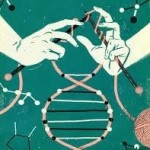TBT: Synthetic Biology (July 2010)
Editors note: This post on Synthetic Biology was originally published on the BioBlog 18 July 2010. While he at one point mentions that he doesn’t “pretend to be an expert” on SynBio, author Eric Kessler has gone on to do some amazing work with his students in the field. Somethings have changed in six years (here is a story by Ed Yong from March 2016), but please enjoy this look back into our archives.
A little over a year ago, Brad posted a link to a survey on Synthetic Biology. Although it appears that little has fundamentally changed since then, this burgeoning field, along side nanotechnology, has become front page news, and will hopefully become a topic of conversation in your biology class in the near future.
I don’t pretend to be an expert on Synthetic Biology but I thought a few resources may provide you with enough background knowledge to approach the topic with your students this year. Maybe they could use this post itself as a springboard for discussion or more research. The post is in three parts, each accompanied by some thought provoking quotes from Mary Shelley’s Frankenstein…
Early Years and Standford’s Drew Endy
In these links you will will find a reference to one of the first papers in the field, a few comic responses to the field, and links to two YouTube videos (originally TED Talks) of Drew Endy explaining the difference between Synthetic Biology and the more standard and familiar recombinant DNA and genetic engineering technologies.
“The world was to him a secret which he desired to divine. Curiosity, earnest research to learn the hidden laws of nature, gladness akin to rapture, as they were unfolded to him, are among the earliest sensations he can remember . . . It was the secrets of heaven and earth that he desired to learn; and whether it was the outward substance of things or the inner spirit of nature and the mysterious soul of man that occupied him, still his inquiries were directed to the metaphysical, or in it highest sense, the physical secrets of the world.”
- Synthetic Biology: Engineering Escherichia coli to see light (November 2005)
- Nature’s comic on Synthetic Biology (November 2005)
- The Story of Synthia – another comic look at synthetic biology
- Synthetic Biology Organization with a press link to numerous popular critiques of synthetic biology
- SEED’s Cribsheet on Synthetic Biology (July 2010)
(June 2007)
(December 2008)
Venter creates the News & President Obama’s Responds
“There was none among the myriads of men that existed who would pity or assist me; and should I feel kindness towards my enemies? No: from that moment I declared everlasting war against the species, and, more than all, against him who had formed me and sent me forth to this insupportable misery.”
(May 2010)
- The President’s Emerging Technologies Interagency Policy Coordination Committee’s Inaugural Meeting (May 2010)
- NPR Story, Presidential Panel Scrutinizes Synthetic Biology (July 2010)
Resources for those interested in Doing some Synthetic Biology
The following resources are for entering the field of Synthetic Biology. The first link will introduce you to an annual competition used to motivate undergraduate teams of students to design and engineer novel pathways in E. coli. If you search around, I think that you’ll find that there has been a single high school team involved in the competition before. Some of university sponsors are quite interested in developing a kit to introduce students to the methods synthetic biology.
- iGEM 2010
- Authentic Teaching and Learning through Synthetic Biology based the E. coli engineered to sense light
- The BioBricks Foundation
- Registry of Standard Biological Parts
- BioBrick Assembly Kit from New England BioLabs
“‘The labours of men of genius, however erroneously directed, scarcely ever fail in ultimately turning to the solid advantage of mankind.”

 Next Post
Next Post